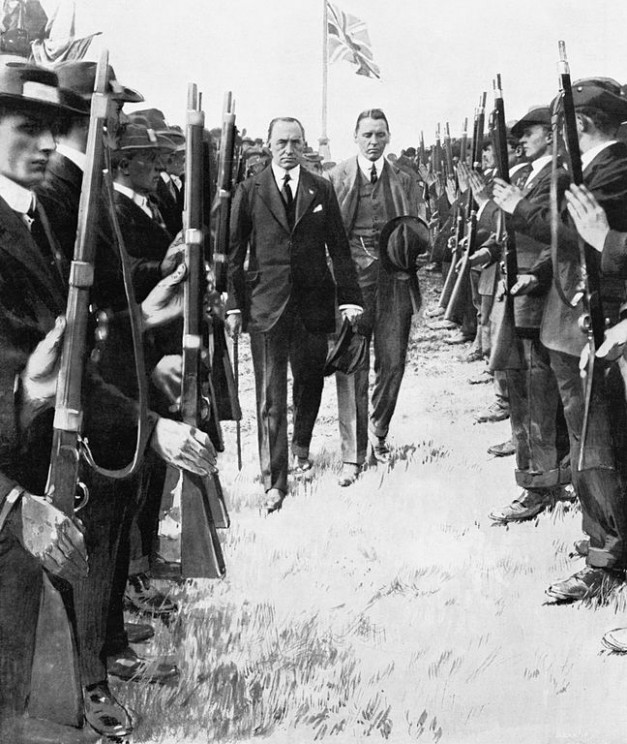This is the centenary year of the enactment of the third Home Rule Bill, as well (of course) as the year of the Scottish referendum on independence. Yet the centenary conversation in Ireland and the somewhat more vigorous debate upon Scots independence, have been conducted — for the most part — quite separately.
While it would be wrong to push the analogies too far, there are some striking similarities – and some differences – between the debate on Home Rule in 1912-14, and the current debate upon Scottish independence. These similarities (and indeed distinctions) might well give food for thought to the protagonists within the Scottish ‘Yes’ and ‘Better Together’ camps — and indeed there is evidence that both Gordon Brown and Alex Salmond have ruminated accordingly.
One critical difference between Ireland in 1914 and Scotland in 2014 is that of militancy — Ireland on the eve of the First World War being an armed camp comprising the Ulster and Irish Volunteer movements, opponents and proponents of Home Rule, as well as the British Army. The Scottish political debate has not been militarised, and there is no evidence that it will become so (the Scottish National Liberation Army, for example, has never posed a significant threat). Modern Scottish nationalism has developed as a wholly constitutional and pacific phenomenon.
Of course mainstream Scottish nationalism has only recently, through successive Holyrood elections, emerged as a majority phenomenon. But it has never had to encounter the challenge (faced by Irish nationalism a century ago) of returning a majority of elected representatives, while being lengthily resisted in London.
One aspect of the Irish experience in 1914 was that a fraught constitutional debate, heightened political expectations, and the delaying or disappointment of those expectations (with Unionist resistance and the onset of War), combined to make a highly volatile political chemistry. The hardening expectations of change across Scotland in 2014 mean that national (as well as social and economic) aspirations may need to be quickly and sensitively addressed, whatever the result of the referendum.

One critical dimension of this militancy in 1914 was the trenchant support given to Ulster Unionist paramilitarism by the British Conservative leadership — this in part a symptom of the profound divisions in British and Irish politics and society precipitated by the debate over Home Rule. It is striking that both the Home Rule issue in 1914 and the referendum in 2014 have each attracted an unusually broad range of declarations of allegiance from a complex array of interest groups and individuals. In 1914 there was a high level of ‘celebrity’ endorsement and intervention over Home Rule: taking literary figures alone, Sir Arthur Conan Doyle came out as a Home Ruler, while Rudyard Kipling was a strong Unionist. In 2014 Irvine Welsh has declared in favour of independence, while J.K. Rowling is against. Ian Rankin provides a case-study in the complexity (and profundity) of division: he is an agnostic on the issue, but is clear that his characters would have strong opinions. So, Inspector Rebus joins the unionists of 2014 (though the actor Ken Stott, most recent of the TV Rebuses, is reportedly in the ‘yes’ camp).
The analogies between Home Rule and the debate on Scottish independence extend much further than the ‘A’ list, however. The substantial strength and challenge of Home Rule sentiment produced striking intellectual movement before and in 1914 — just as the strength of the movement for Scots independence has produced similar movement a century later.
In 1912-14 the constitutional impasse over Home Rule in fact helped to stimulate support for (what was then called) ‘federalism’ among some of the Unionist elite, including even Edward Carson. In terms of the (nearly) equally weighted forces fighting over Scottish independence, Gordon Brown has now moved to embrace the idea of a federal United Kingdom; and he has been joined or preceded by others, including (for example) the Scottish Conservative journalist, David Torrance. Discussion of a possible English parliament was broached prominently in 1911-1914 and again in 2014. Both in 1914 and in 2014 it appears that the constitutional shape of the ever-malleable United Kingdom is once again in transition — but because unionists are now shifting no less then nationalists.
And indeed some Scots Nationalists have moved towards embracing at least some of the symbols of the British connection. John Redmond, the Home Rule leader, emphasised monarchy and empire in his vision of Irish autonomy during the Home Rule era, partly through personal conviction, and partly in terms of subverting unionist arguments. In similar vein, Alex Salmond (despite a strong tradition of republican sentiment within the SNP), has embraced the ‘union of the crowns’ as SNP strategy, and has in recent years referred deferentially to the Queen (‘of Scots’), and her central place in an independent nation.
Here, as elsewhere, Ireland’s century-old debate on Home Rule speaks to the current condition of Scotland. Indeed here, as elsewhere, Ireland’s wider experience of Union chimes with that of the Scots.
The post Shamrock and Saltire: Irish Home Rule and the Scottish Referendum, 1914-2014 appeared first on OUPblog.


